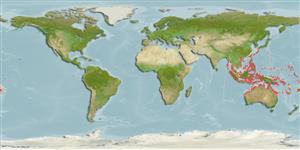>
Ovalentaria/misc (Various families in series Ovalentaria) >
Pomacentridae (Damselfishes) > Pomacentrinae
Etymology: Pomacentrus: Greek, poma, -atos = cover, operculum + Greek, kentron = sting (Ref. 45335).
More on authors: Fowler & Bean.
Environment: milieu / climate zone / depth range / distribution range
Écologie
marin récifal; non migrateur; profondeur 1 - 12 m (Ref. 9710). Tropical; 32°N - 25°S, 92°E - 173°W
Indo-West Pacific: including Andaman Sea (Phuket), Indo-Malayan Archipelago, the GBR, and islands of Melanesia and Tonga; occurs northward to the Ryukyu Islands. in Japan.
Taille / Poids / Âge
Maturity: Lm ? range ? - ? cm
Max length : 9.0 cm SL mâle / non sexé; (Ref. 7247)
Description synthétique
Clés d'identification | Morphologie | Morphométrie
Épines dorsales (Total) : 13; Rayons mous dorsaux (Total) : 14 - 15; Épines anales: 2; Rayons mous anaux: 14 - 15.
Adults inhabit lagoons, passages, and outer reef slopes. Feed on zooplankton in the water column, a short distance from the bottom. They occur singly or in small groups (Ref. 7247). Oviparous, distinct pairing during breeding (Ref. 205). Eggs are demersal and adhere to the substrate (Ref. 205). Males guard and aerate the eggs (Ref. 205). Diurnal species (Ref. 113699).
Life cycle and mating behavior
Maturité | Reproduction | Frai | Œufs | Fécondité | Larves
Oviparous, distinct pairing during breeding (Ref. 205). Eggs are demersal and adhere to the substrate (Ref. 205). Males guard and aerate the eggs (Ref. 205).
Allen, G.R., 1991. Damselfishes of the world. Mergus Publishers, Melle, Germany. 271 p. (Ref. 7247)
Statut dans la liste rouge de l'IUCN (Ref. 130435: Version 2024-2)
Menace pour l'homme
Harmless
Utilisations par l'homme
Pêcheries: hautement commercial
Outils
Articles particuliers
Télécharger en XML
Sources Internet
Estimates based on models
Preferred temperature (Ref.
123201): 25.2 - 29.3, mean 28.5 °C (based on 1864 cells).
Phylogenetic diversity index (Ref.
82804): PD
50 = 0.5000 [Uniqueness, from 0.5 = low to 2.0 = high].
Bayesian length-weight: a=0.02692 (0.01699 - 0.04265), b=3.04 (2.90 - 3.18), in cm total length, based on LWR estimates for this species & Genus-body shape (Ref.
93245).
Niveau trophique (Ref.
69278): 3.4 ±0.45 se; based on food items.
Résilience (Ref.
120179): Haut, temps minimum de doublement de population inférieur à 15 mois (Preliminary K or Fecundity.).
Fishing Vulnerability (Ref.
59153): Low vulnerability (10 of 100).
Nutrients (Ref.
124155): Calcium = 127 [61, 209] mg/100g; Iron = 0.858 [0.487, 1.457] mg/100g; Protein = 18.3 [17.1, 19.4] %; Omega3 = 0.115 [0.062, 0.201] g/100g; Selenium = 17.8 [8.7, 37.6] μg/100g; VitaminA = 179 [53, 596] μg/100g; Zinc = 1.57 [1.00, 2.34] mg/100g (wet weight);
